Did you know Flagstaff sits at about 7,000 feet and sees over 200 inches of snow some winters? You’ll find pine forests, volcanic peaks, and Route 66 nostalgia within a short drive. This guide shows top hikes, stargazing spots, food and breweries, and smart day-trip plans so you can pick what fits your pace — from easy museum strolls to summit treks — and pack right for sudden mountain weather.
Why Visit Flagstaff: Highlights at a Glance
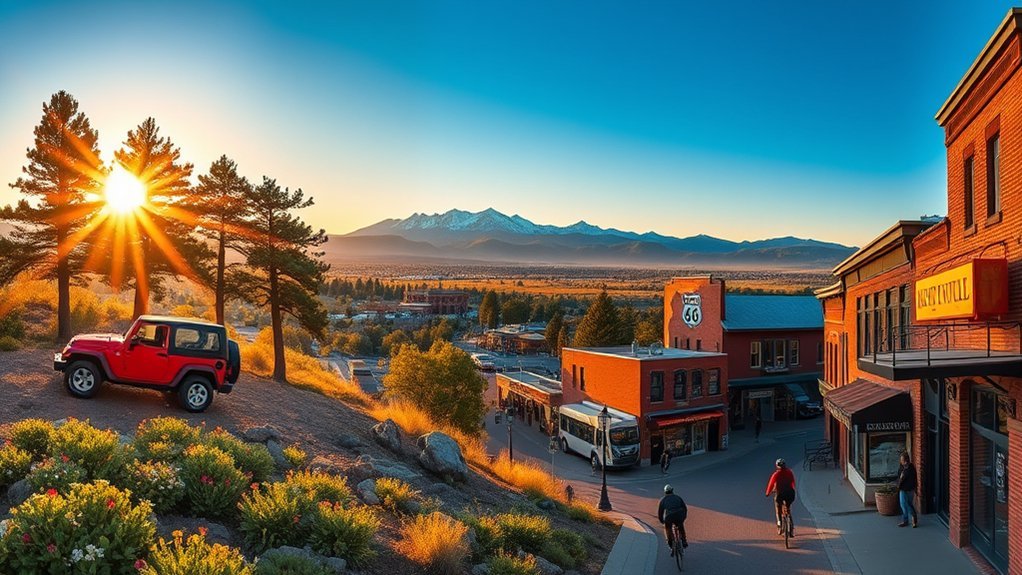
When you visit Flagstaff, you’ll find a high-desert town that blends easy outdoor access with a lively cultural scene: snow-capped peaks and ponderosa forests frame miles of hiking and biking trails, while a compact downtown offers craft breweries, Route 66 history, and museums that celebrate Native American and astronomical heritage. You’ll explore the Lowell Observatory to gaze at the cosmos where Pluto was discovered, stroll historic downtown to see vintage neon and local galleries, and sip small-batch beer after a day on varied trails. The nearby Walnut Canyon and Sunset Crater provide accessible geological and archaeological wonders, while the Arizona Snowbowl offers alpine views and summer chairlift rides. You’ll appreciate a strong Native presence in cultural centers and public art, and find family-friendly attractions like the Arboretum at Flagstaff and train-themed exhibits. Compact neighborhoods make it easy to mix outdoor adventure, food, and cultural learning without long drives, so you can maximize your time.
Best Times to Go and Weather Considerations
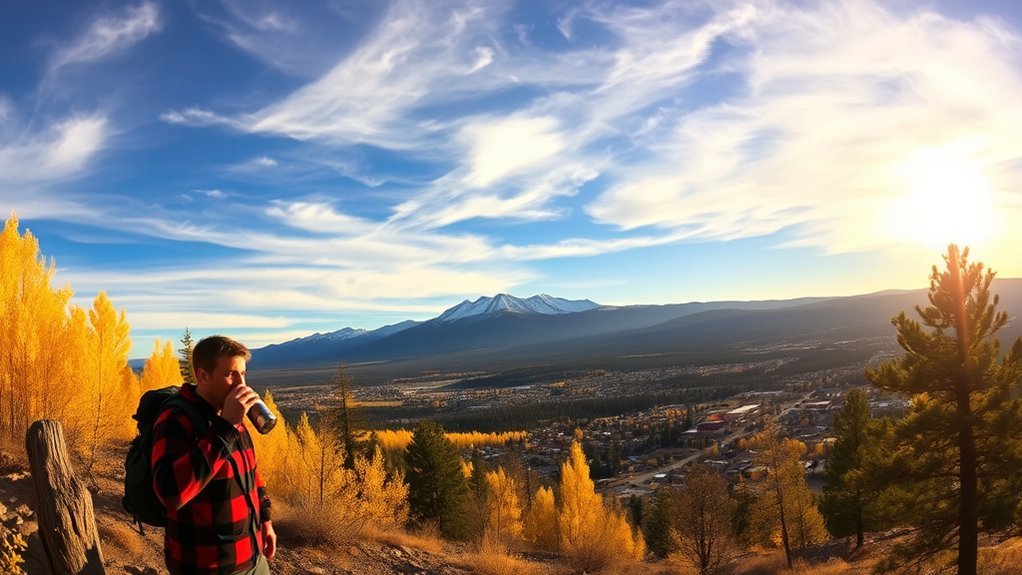
Because Flagstaff sits at about 7,000 feet, you’ll find its seasons feel more alpine than desert—summers are pleasantly mild and winters bring real snow—so choosing the right time depends on what you want to do. If you crave hiking, wildflowers and cooler temps make late spring (May–June) and early fall (September) ideal; trails are accessible and afternoons are comfortable. Summer (July–August) brings occasional monsoon storms—expect dramatic skies, brief heavy rain, and cooler nights—so pack a light rain shell and plan afternoon activities around thunderstorms. Winter (December–March) turns Flagstaff into a snowy playground for skiing and cozy nights by a fire; roads can ice, so check forecasts and carry traction aids if you drive. Shoulder seasons give fewer crowds and lower prices. Daytime temperatures can swing wildly, so layer clothing, bring sun protection, and hydrate at altitude. Always monitor local weather and sunset times to make the most of your visit.
Getting There and Getting Around
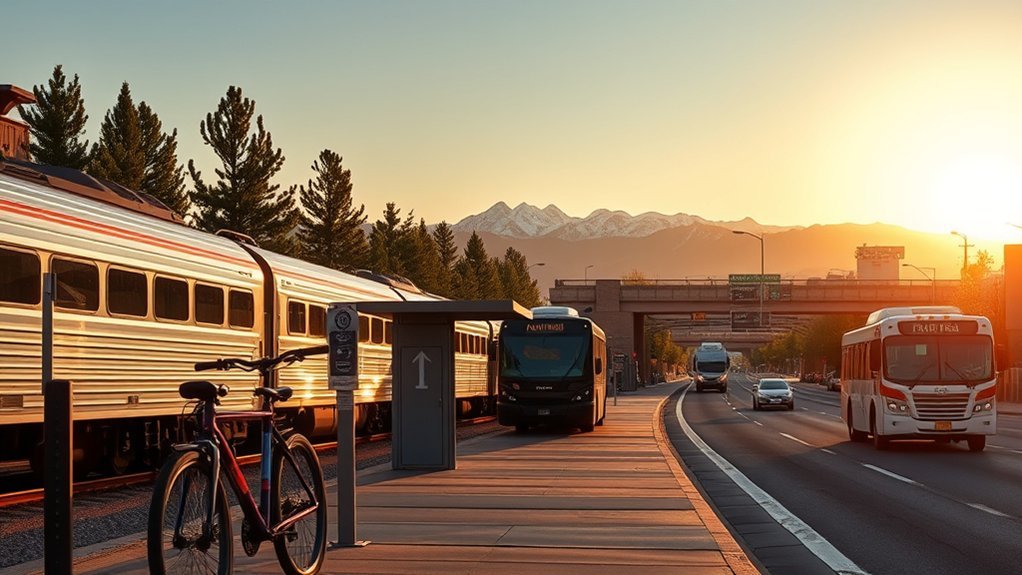
Getting to Flagstaff is straightforward whether you’re flying into the regional airport, driving the scenic I-40, or coming by Amtrak. Once you’re here, you’ll find bus routes, bike lanes, rideshares, and easy rentals to help you move around town and reach nearby parks. Keep an eye on winter road conditions, parking rules in downtown and at trailheads, and permit or fee requirements to avoid surprises.
Getting to Flagstaff
How will you arrive in Flagstaff? Plan ahead: you can fly into Pulliam Airport, drive scenic routes, or take the train for a relaxed approach. Each option sets the tone—speed, scenery, or nostalgia.
| Option | Notes |
|---|---|
| Plane | Short regional flights to Pulliam Airport (FLG). |
| Car | I-40 connects east-west; US-180 and SR-89A offer scenic turns. |
| Train | Amtrak’s Southwest Chief stops downtown. |
| Bus | Regional carriers link to Phoenix and Tucson. |
Decide based on time and mood: flying saves hours, driving rewards you with views of ponderosa forests and volcanic fields, the train feels classic and easy, and buses are budget-friendly. Once you choose, book early during peak seasons and check road or weather alerts for a smooth arrival.
Local Transportation Options
Once you’re in town, Flagstaff gives you a mix of practical and scenic ways to get around—rent a car for the widest range, hop the Mountain Line bus for cheap local routes, grab a rideshare or taxi for quick hops, or pedal through bike-friendly corridors and trails if the weather’s right. You’ll find the downtown grid compact and walkable, with shops, breweries, and historic sites close together. Mountain Line’s routes link neighborhoods, NAU, and the transit center; buses run frequently and are budget-friendly. If you want flexibility, car rentals let you reach nearby natural attractions. Cycling rewards you with fresh air and views on designated lanes and multiuse paths. Plan for seasonal weather and bring layers for windy, cool evenings.
Parking and Road Tips
If you’re driving into Flagstaff, plan ahead for a mix of free and paid parking—downtown offers metered spots and short-term lots while neighborhoods and trailheads may have limited free spaces that fill up fast on weekends and holidays. You’ll find municipal garages near shops and restaurants; watch posted hours and pay stations, and download the city parking app to save time. On busy days, use park-and-ride at transit hubs or park on quieter side streets where allowed. Winter brings snow restrictions and occasional closures—check local alerts and carry chains if venturing to higher elevations. Drive confidently but cautiously on winding forest roads, obey speed limits, yield to wildlife, and expect slower traffic during peak tourist seasons.
Where to Stay: Neighborhoods and Accommodation Types
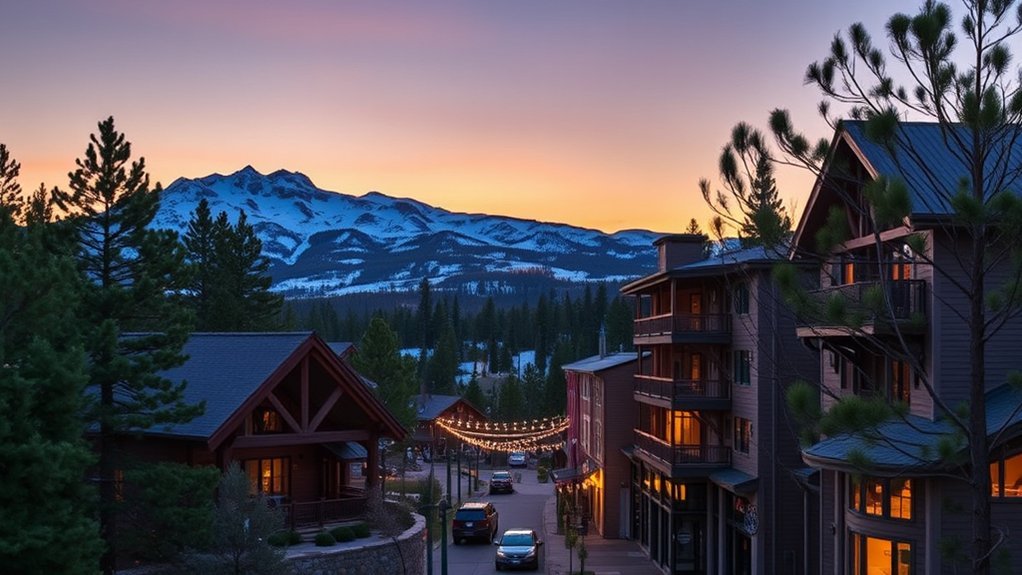
You’ll find two appealing bases for your Flagstaff stay: the walkable Downtown Historic District with its boutiques, breweries, and rail-era charm, or the mountain-side motels and lodges that put you closer to pine forests and scenic trails. Staying downtown keeps you within easy walking distance of restaurants, museums, and nightlife, while choosing a mountain motel or lodge gives you quieter nights and quick access to outdoor adventures. Pick based on whether you want lively streets and history at your doorstep or rustic, nature-focused accommodations just outside town.
Downtown Historic District
Cobblestone streets and brick-front storefronts make Flagstaff’s Downtown Historic District an ideal base if you want walkable access to restaurants, breweries, shops, and heritage sites. You’ll find boutique hotels, renovated Victorian inns, and several small B&Bs tucked between coffee shops and craft pubs. Choose a room near the railroad tracks for a touch of history, or a quieter side street if you prefer evenings without nightlife noise. Mornings are perfect for exploring galleries and the Route 66 nostalgia; evenings bring live music and a lively dining scene within easy reach. Walkability means you can park once and rely on feet or short rideshares. Book early for festival weekends and check for rooms with parking included.
Mountain & Motel Options
Beyond the lively blocks of the Downtown Historic District, Flagstaff’s lodging options stretch into mountain-side retreats and classic roadside motels that suit very different trip styles. You’ll find quiet cabins tucked into Ponderosa pines, upscale lodges with rustic charm, and no-frills motels along historic Route 66 — each setting shapes how you experience the region.
- A cedar-clad cabin on a slope: wake to pine-scented air and panoramic sunrise views.
- A boutique lodge near the arboretum: polished wood interiors and easy access to trails.
- A family-run motel on Route 66: retro signage, simple rooms, quick highway access.
- A mountain B&B: home-cooked breakfasts and local tips for stargazing and hiking.
Must-See Attractions in and Around Town
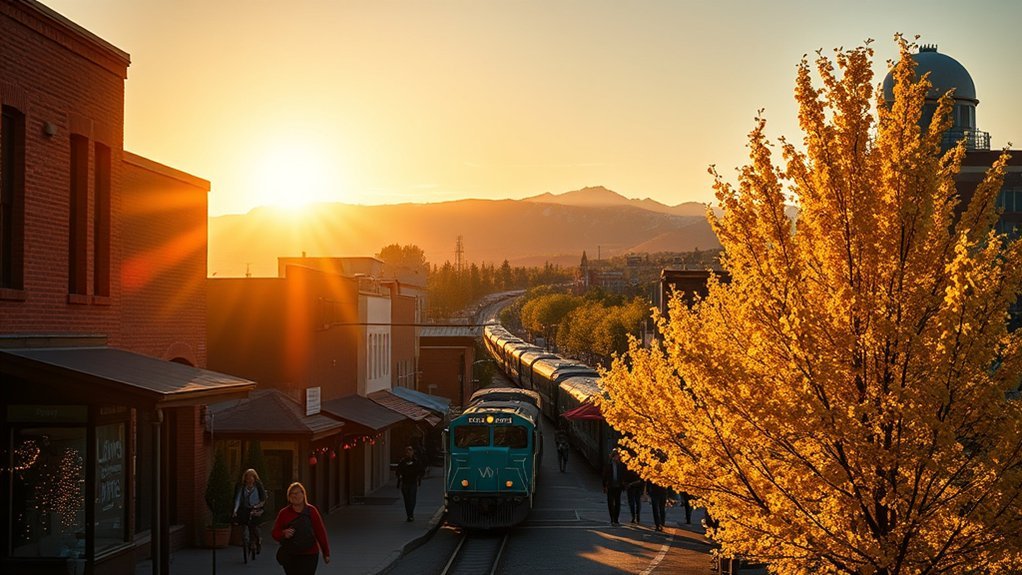
When you step into Flagstaff, you’ll find a compact city that’s surrounded by dramatic landscapes and packed with attractions worth planning for—historic downtown, the Lowell Observatory, and the nearby red-rock splendor of Sedona each offer distinct experiences that are easy to reach. You’ll want to wander the brick-lined streets of downtown, where galleries, brewpubs, and Route 66 nostalgia mix with Victorian architecture and local shops. Visit the Lowell Observatory for guided tours, telescope viewings, and astronomy exhibits that make the cosmos feel immediate. Don’t miss the Museum of Northern Arizona to learn about Indigenous cultures, geology, and regional natural history through engaging displays. For a different pace, drive the scenic Arizona Snowbowl area roads for panoramic views and a leisurely summit outlook. Nearby Walnut Canyon National Monument delivers cliff-dwelling ruins and interpretive trails that reveal ancient Sinagua life. These spots give you cultural depth, stellar science, and easy-access history without needing extensive travel time.
Outdoor Activities: Hiking, Biking, and Winter Sports
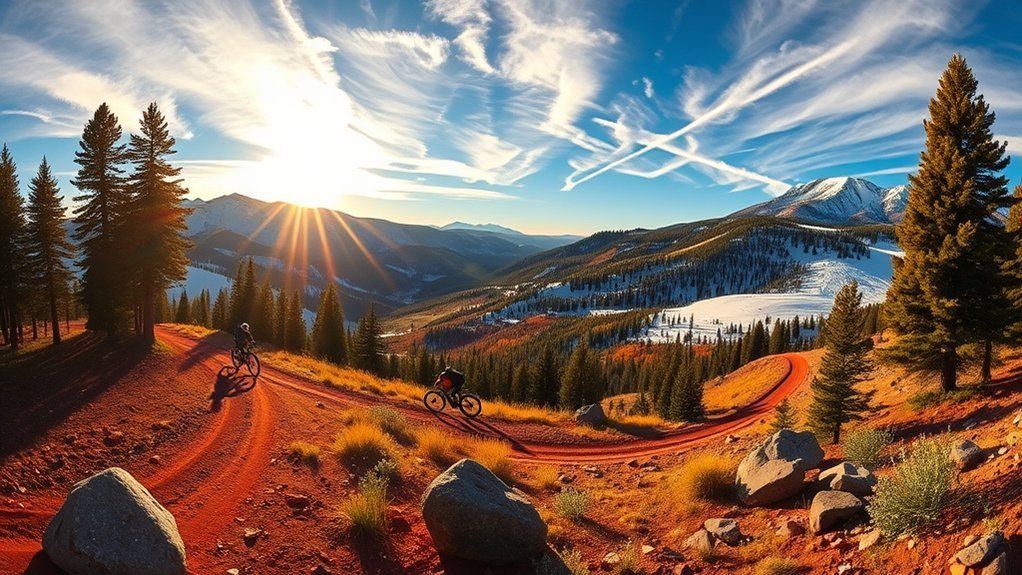
If you’ve enjoyed Flagstaff’s museums and scenic drives, lace up your boots or hop on a bike—this area practically begs you outdoors. You’ll find trails through ponderosa pine, volcanic cinder cones, and alpine meadows that change with the light. Day hikes like Humphreys Peak offer challenging gains and panoramic payoff; shorter loops around Walnut Canyon put ancient cliff dwellings in easy reach. Mountain biking trails vary from flowy singletrack in the Buffalo Park network to technical descents near Elden Mountain. Come winter, Arizona Snowbowl transforms the San Francisco Peaks into a playground for downhill skiers, snowboarders, and fat-bike riders; cross-country tracks and snowshoe routes thread quieter forests.
- Picture yourself cresting Humphreys Peak at sunrise, clouds below and snow-glinted rocks underfoot.
- Imagine carving fresh turns at Snowbowl with pine-scented air and wide sky.
- Visualize pedaling red dirt singletrack beneath dappled pine canopy.
- See peaceful cross-country routes where quiet snowfall muffles the world.
Respect altitude, pack layers, and check trail conditions before heading out.
Day Trips: Grand Canyon, Sedona, and Beyond
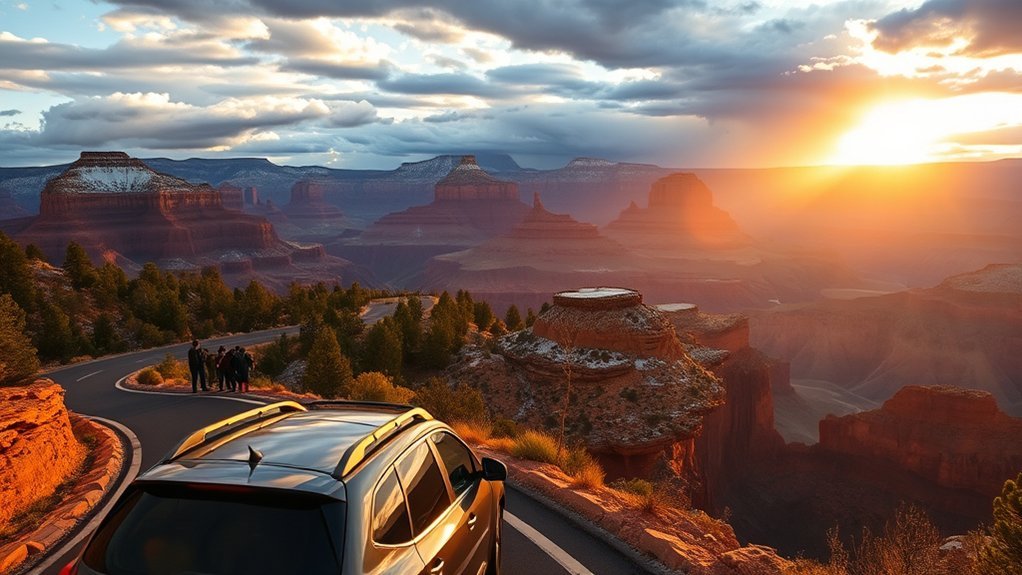
From Flagstaff you can reach the Grand Canyon in about 90 minutes, so you can stand on the rim at sunrise and still be back for dinner. Sedona’s red-rock panoramas and the meandering Oak Creek offer easy hikes, scenic drives, and peaceful creekside spots for a picnic. Both trips are perfect for a day — bring layers, water, and a camera for dramatic landscape shots.
Grand Canyon Day Trip
Set out early to make the most of a Grand Canyon day trip—it’s only about a 90-minute drive from Flagstaff to the South Rim, and the views are worth every minute on the road. You’ll arrive to layered cliffs, endless sky, and crisp air; plan sunrise or mid-morning light for best photos. Walk the Rim Trail for easy, panoramic viewpoints, or stop at Mather Point and Yavapai Observation Station for geology and history. Bring water, snacks, sun protection, and sturdy shoes—weather shifts fast. If you want a quick immersion, choose a short side hike or ranger talk. Leave time to watch the canyon glow at golden hour before you head back to Flagstaff.
- Red-orange cliffs under a vast blue sky
- Shadowed crevices and sunlit ridges
- Wind-tossed pines framing lookout points
- Silent expanses stretching to the horizon
Sedona & Oak Creek
Often the drive to Sedona feels like stepping into a painting—red rock spires, twisted junipers, and Oak Creek’s clear ribbon of water draw you in for easy explorations and dramatic photo ops. You’ll find iconic viewpoints like Bell Rock and Cathedral Rock near the main drag, but don’t miss quieter spots along Oak Creek Canyon. Hike the West Fork for shaded stream crossings and fall colors, or picnic at Grasshopper Point where swimmers and photographers converge. Artsy uptown Sedona offers galleries, cafes, and guided jeep tours that explain geology and native history. Time your visit for morning light or golden hour; parking fills quickly. Plan a half- to full-day trip from Flagstaff and bring water, sturdy shoes, and a camera.
Historic Route 66 and Downtown Flagstaff
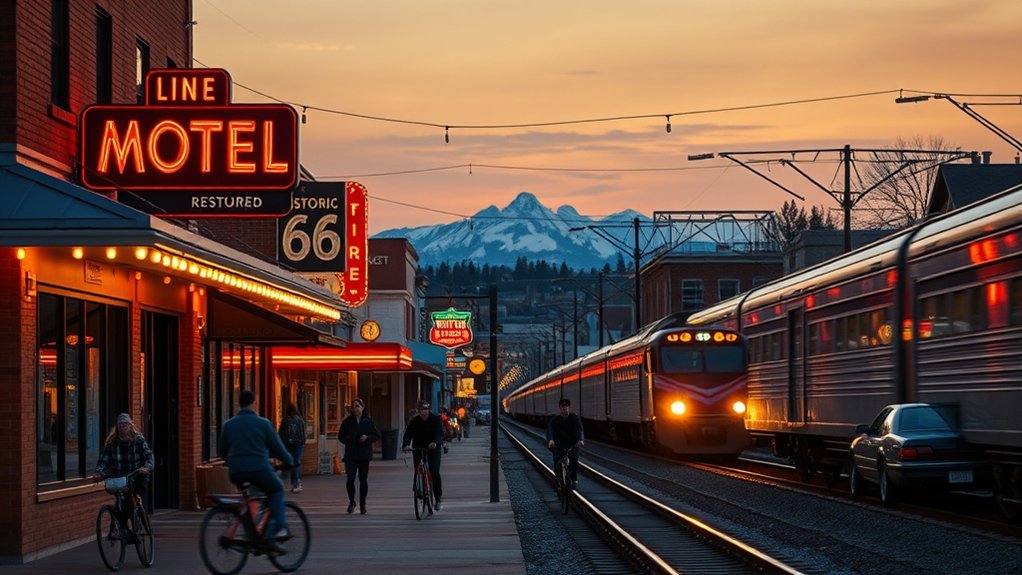
Roll along Historic Route 66 through downtown Flagstaff and you’ll find a compact, walkable district where neon signs, brick storefronts, and craft breweries mingle with Route 66 nostalgia. You can trace the original Mother Road past vintage motels, restored theaters, and quirky diners while snapping photos of retro signage and murals that celebrate travelers from decades past. Stroll pine-shaded streets to discover independently owned shops, galleries, and a train station anchoring the town’s railroad heritage. Interpretive plaques and a small museum fill in the history, so you’ll leave with a sense of Flagstaff’s role in westward travel.
- Neon motel sign glowing against a high-desert sunset.
- Brick facade with a hand-painted Route 66 mural.
- Steam locomotive parked near the historic depot platform.
- Window displays of vinyl records, handcrafted wares, and vintage postcards.
You’ll want comfortable shoes and time to wander; downtown rewards slow exploration and photo stops.
Food, Breweries, and Local Nightlife
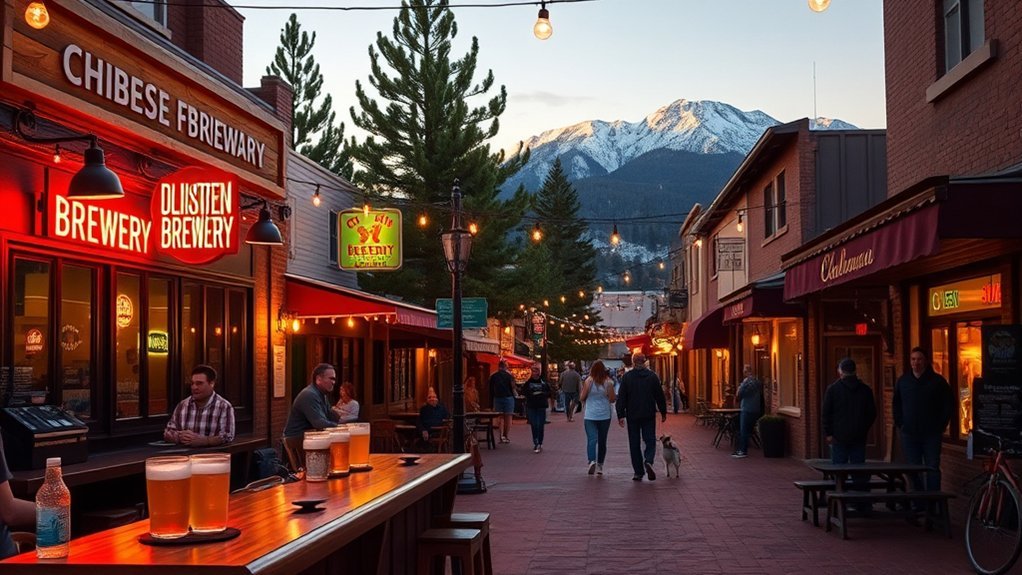
You’ll quickly discover that Flagstaff’s food scene blends hearty mountain comfort with inventive regional flavors, and its breweries and nightlife keep things lively after dark. You can start your day with locally roasted coffee and pastries, then sample Navajo-inspired dishes or wood-fired pizzas for lunch. Dinner options range from elk steaks and craft tacos to vegetarian plates using seasonal, high-altitude produce.
Flagstaff’s brewery scene is a highlight: tasting rooms offer rotating taps, house saisons, IPAs, and barrel-aged stouts. You can join brewery tours or hop between downtown spots on foot, enjoying outdoor patios when the weather’s mild. Live-music venues and intimate bars host local bands, open-mic nights, and themed events—perfect for catching emerging talent.
For a relaxed evening, pick a rooftop patio or cozy pub; for a livelier night, head to the historic downtown strip where bars stay open late. No matter your taste, Flagstaff serves approachable, adventurous food and spirited nightlife that complement its outdoor lifestyle.
Practical Tips: Permits, Safety, and Packing Recommendations
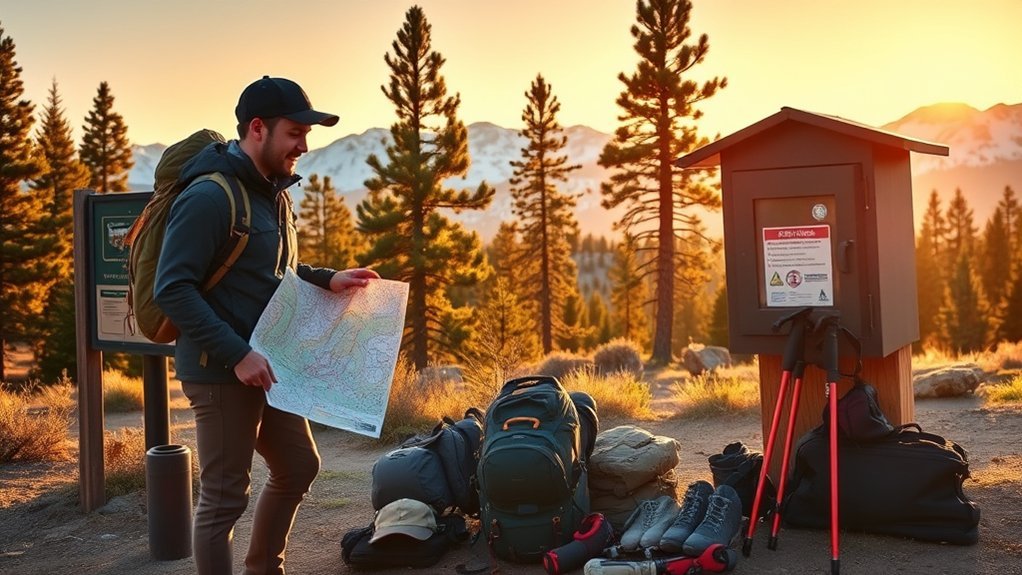
Because Flagstaff sits at high elevation and borders protected public lands, you should plan ahead for permits, safety, and the right gear to make your trip smooth and secure. Acclimate slowly to altitude—drink water, avoid heavy exertion your first day, and watch for headache, nausea, or dizziness. Check park websites for permits; some trailheads and wilderness areas require reservations or fees. Carry layers: nights get cold and sun is intense at 7,000+ feet. Bring a map, headlamp, first-aid kit, and extra snacks. Let someone know your route, and expect variable weather.
- Trailhead signboards showing permit kiosks and route maps.
- A layered outfit: fleece, wind shell, sun hat, sturdy boots.
- Essentials: water filter, compass/GPS, headlamp, extra batteries.
- Safety scene: parked car with permit on dash, emergency blanket, phone power bank.
Respect closures, pack out trash, and stay aware of wildlife and fire restrictions to protect you and the landscape.
Frequently Asked Questions
Are There Any Allergy-Friendly Restaurants in Flagstaff?
Yes — you’ll find allergy-friendly options in Flagstaff; many restaurants accommodate gluten-free, dairy-free, and nut allergies, like Pizzicletta, MartAnne’s, and Natural Market Café, and staff will usually adjust dishes when you ask.
Can I Bring My Pet to National Parks Nearby?
Yes — but rules vary: pets are allowed on many park trails yet restricted in wilderness areas, so you’ll need to check specific park regulations, leash requirements, and pet-friendly services before visiting to keep both your pet and wildlife safe.
Where Can I Find Local Live Music Schedules?
Check local venue websites like The Orpheum and Historic Brewing, follow Facebook event pages, use Bandsintown and Songkick, visit Downtown Flagstaff’s visitor center, and scan local papers and posters — you’ll spot shows, lineups, and ticket info.
Is There Reliable Cell Service Throughout Flagstaff?
Like a patchwork quilt, cell coverage in Flagstaff’s urban core is generally reliable, but you’ll hit spotty service in surrounding forests, canyons, and some high-elevation areas; carry offline maps and a backup hotspot just in case.
What Cultural Festivals Occur Annually in Flagstaff?
You’ll find annual cultural festivals like the Flagstaff Folk Festival, the Lowell Observatory’s Starry Nights events, Indigenous Peoples’ celebrations, the Flagstaff Hullabaloo, and seasonal arts/music festivals showcasing local Native, Hispanic, and Southwest heritage.
Conclusion
You’ll leave Flagstaff smug with fresh air and slightly more knowledge of geology than you ever asked for. Pack layers, a camera, and a healthy respect for mountain weather (and for the ravenous appetite you’ll develop for local craft beer). Drive to the Grand Canyon like you mean it, stroll downtown like you own a Route 66 postcard, and remember: the stars aren’t a light show — they’re judgmental critics of your camping choices.

